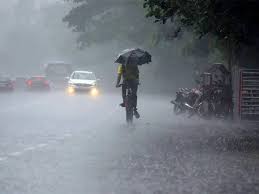Two killed after poultry farm’s wall collapses in Odisha, heavy rain alert issued for 16 districts

Relentless rain in Odisha triggered a tragic incident on Sunday in Nuapada district. Two women died and a child was injured after the wall of a poultry farm under construction suddenly collapsed. The accident occurred in the Lakhana area around 11 AM, while the victims were nearby.
The deceased have been identified as Balmati Sabar, 35, and Rupe Sabar, 61. Both women were crushed under the debris. Eight-year-old Ridhi Sabar, who was with them, survived with injuries and is now receiving treatment at a local hospital.
Locals rushed to the site and helped pull the victims from the rubble. Rescue workers arrived soon after to assist. Authorities believe the structure gave way due to the persistent rain that had soaked the foundation and weakened the wall.
IMD Issues Alerts for 16 Districts as Rains Intensify
As monsoon activity increases, the India Meteorological Department (IMD) has issued alerts for 16 districts in Odisha. The alerts fall under two categories—orange and yellow—signaling varying levels of weather-related risk.
Orange Alert (Heavy to Very Heavy Rain Likely):
- Nuapada
- Keonjhar
- Angul
- Deogarh
- Sambalpur
- Sundargarh
- Jharsuguda
- Bargarh
This alert asks residents and local administrations to prepare for possible disruptions and take action to prevent damage.
Yellow Alert (Moderate Rain with Thunderstorms):
- Cuttack
- Dhenkanal
- Nayagarh
- Kalahandi
- Kandhamal
- Boudh
- Sonepur
- Balangir
This category urges people to stay cautious, especially in areas prone to flooding and landslides.
In addition, thunderstorms with lightning are forecasted in coastal and central Odisha, including Balasore, Jajpur, Jagatsinghpur, Bhadrak, and Kendrapara.
Flood Concerns Grow as Dam Gates Open
With rain lashing both upstream and downstream regions, the Hirakud Dam authorities have opened 20 sluice gates to manage water levels in the Mahanadi River. Though the water level remains under the danger mark for now, officials are closely monitoring the situation.
To tackle any emergencies, the Odisha Disaster Rapid Action Force (ODRAF) and National Disaster Response Force (NDRF) teams have been placed on high alert. Local governments in affected districts are activating relief shelters and stocking essential supplies.
Revenue and Disaster Management Minister Sudam Marndi said that district officials must remain fully prepared. He also asked citizens to stay indoors unless travel is absolutely necessary.
Unsafe Construction and Climate Risks: A Deadly Mix
The Nuapada wall collapse brings attention to a deeper issue—unsafe rural construction in the face of changing climate patterns. In many villages, walls and structures are built without proper engineering support. When exposed to heavy rains, they quickly become unstable.
Experts have warned that climate change is intensifying India’s monsoons. While some areas see prolonged dry spells, others face sudden and severe rainfall. These conditions increase the risk of collapses, landslides, and floods.
“In regions like Nuapada, even short bursts of rain can weaken buildings,” said a civil engineer from Bhubaneswar. “We need stricter construction norms and regular inspections, especially before the monsoon.”
Government Responds with Aid and Warnings
Following the deaths, the Odisha government has announced compensation for the families of the victims. A probe has also been launched to examine whether the wall was built legally and with proper safety checks.
Meanwhile, the IMD is upgrading its rain forecasting systems to issue more accurate, location-specific alerts. The goal is to warn people earlier and help them move to safer places when needed.
Fishermen along Odisha’s coast have been advised not to venture out to sea. The IMD expects rough waters for the next two days and urges coastal communities to take precautions.
Looking Ahead: Odisha Must Strengthen Preparedness
This tragedy in Nuapada is not an isolated case. Every year, heavy monsoon rains cause wall collapses, electrocutions, and floods in vulnerable regions. The state must now focus on prevention, not just rescue and relief.
Stronger buildings, better drainage, early warnings, and local awareness campaigns can save lives. Odisha has made progress in disaster response, but events like this show that gaps remain.
As the monsoon season continues, residents must stay informed, follow weather updates, and report any unsafe structures to local authorities. In a changing climate, preparation is the key to protection.






